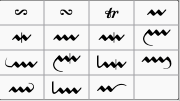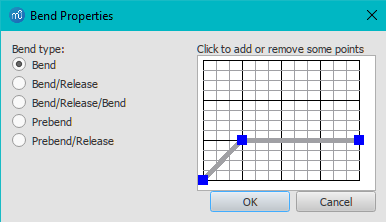Articulations and ornaments
A comprehensive set of symbols can be found in the Articulations palette in the Advanced workspace:

and the Ornaments palette (Advanced workspace):

There is also an abbreviated version of Articulations palette in the Basic workspace.

To add verbal articulation objects available in the Text palette (pizz. , arco etc) to a score, see Staff Text and System Text chapter. Guitar bend is covered in Bends chapter. Brass or woodwind articulation (Fall, Doit, Plop, Scoop) is covered in Arpeggios and glissandi.
Articulations
Articulations are the symbols added to the score to show how a note or chord is to be played. The principal symbols in this group are:
- Fermatas
- Accents (>)
- Staccato and variations—including mezzo-staccato (portato), staccatissimo.
- Tenuto
- Marcato (^)
Specialist articulations are also included for bowed and plucked strings, wind instruments etc.
Ornaments
Ornaments include:
- Mordents, Inverted Mordents, Pralltrills
- Trills
- Turns
- Bends
Note: Appoggiaturas and acciaccaturas can be found in the Grace Notes palette.
Add articulation/ornament
Use either of the following methods:
- Select a note or a range of notes, then click a symbol in a palette (double-click in versions prior to 3.4).
- Drag a symbol from a palette onto a notehead.
Add accidental to an ornament
To apply an accidental to an existing ornament, such as a trill:
- Select the note to which the ornament is attached;
- Open the Symbols section of the Master palette;
- Search for and apply the desired accidental to the score (small accidentals can be found using the search term "figured bass");
- Drag the accidental into position (or reposition using keyboard shortcuts or the Inspector).
Add fermata to a barline
Use one of the following methods:
- Select a barline, then click a fermata symbol in a palette (double-click in versions prior to 3.4).
- Drag a fermata symbol from a palette onto a barline in the score.
Note: This does not affect playback.
Keyboard shortcuts
- Toggle Staccato: Shift+S
- Toggle Tenuto(─): Shift+N
- Toggle Accent(>): Shift+V
- Toggle Marcato(^): Shift+O
- Add Acciaccatura (grace note): /
Keyboard shortcuts can be customized in MuseScore's Preferences.
Adjust position
Immediately after adding an articulation or ornament from a palette, the symbol is automatically selected: It can then be moved up or down from the keyboard as follows:
- Press up/down arrow keys for fine positioning (0.1 sp at a time);
- Press Ctrl+↑ or Ctrl+↓ (Mac: Cmd+↑ or Cmd+↓) for larger vertical adjustments (1 sp at a time).
- To flip a symbol to the other side of the note (where applicable), select it and press X.
To enable adjustments in all directions from the keyboard:
- Enter Edit mode on the symbol;
- Press arrow keys for fine positioning (0.1 sp at a time); or press Ctrl+Arrow (Mac: Cmd+Arrow) for larger adjustments (1 sp at a time).
You can also change the horizontal and vertical offset values in the Inspector. To position more than one symbol at a time, select the desired symbols and adjust the offset values in the Inspector.
Note: The symbol can also be repositioned by clicking and dragging, but for more precise control, use the methods above.
Articulation and ornament properties
Fermata is covered in Tempo chapter.
Edit selected object(s)' properties on a score with the Inspector. Under the Articulation heading:
- Placement: Above or below the staff.
- Direction: Auto / Up / Down.
- Anchor: Adjust the vertical placement of the symbol.
- Time stretch: Obsolete. Use Fermatas section of Inspector instead
- Ornament style: Default or Baroque.
- Play: Turn playback on or off.
Edit global style settings in Format→Style→Articulations, Ornaments, see Layout and formatting chapter.
Playback
Playback of note affected by articulation symbols varies among instruments, the general effect:
- Staccato : shorter
- Tenuto(─): longer (no effect on Strings eg violins)
- Marcato (^) : louder and shorter
- Accent (>) : louder (louder than using a Marcato) and longer (no duration extension effect on Strings eg violins)
To find out the effect of each instrument, save your score as .mscx, open it as plaintext, find <Articulation> and its <velocity> and <gateTime> values. see <Articulation name="sforzato"> for accent (>) symbol
To achieve your desired playback, either:
- inside Musescore: add multiple symbols, toggle their Play and Visible properties. You can also set the note itself's Velocity and Velocity type properties, or
- edit per instrument settings in your saved file: save your score as .mscx, open it as plaintext and edit the instrument articulation definitions. These modifications do not affect new instruments added later, or
- edit default settings in instrument.xml affecting new instruments.
See this battle between jazz and classical musicians on the forum for more details.
See also
- Grace notes
- Fermatas in Tempo
- Dynamics (sfz symbol)
External links
- How to create trills and ornaments with accidentals (and playback) (MuseScore HowTo)
- Ornaments at Wikipedia
Bends
Bends, of various kinds, can be created with the Bend Tool  . You can find this in the Articulations palette of the Advanced workspace. Any bend applied to the score can be customized in the Bend section of the Inspector.
. You can find this in the Articulations palette of the Advanced workspace. Any bend applied to the score can be customized in the Bend section of the Inspector.
Apply a bend
To apply one or more bends to the score, use one of the following options:
- Select one or more notes and double-click a bend symbol in the palette.
- Drag a bend symbol from the palette on to a note.
Edit bend
Text and line properties
- Select the bend.
- Adjust the following properties in the Bend section of the Inspector:
- Line thickness.
- Font, Size, Style: Properties of the text.
- Play (checkbox): Whether the bend affects playback or not.
Global text and line properties for all bends in the score can be edited in Format→Style...→Bend.
Bend shape and width
Versions 3.4 and above:
- Make sure that the bend is selected.
- In the "Bend" section of the Inspector use the Bend type dropdown to choose from a range of presets. "Bend" is the default option.
- Make adjustments, as required, to the graphical display of the bend in the Inspector: see Edit graphical display (below).
Versions prior to 3.4:
- Select the bend and click on Properties in the Inspector; Alternatively, right-click on the bend and select "Bend Properties".

- Choose from a range of presets under Bend type. "Bend" is the default option.
- Make adjustments, as required, to the graphical display of the bend: see Edit graphical display (below).
Edit graphical display
The bend is represented by a graph consisting of gray lines connected by square, blue nodes (see image above). The slope of the line indicates the type of bend:
- Up-slope = Up-bend
- Down-slope = Down-bend
- Horizontal line = Hold
The vertical axis of the graph represents the amount by which the pitch is bent up or down: one unit equals a quarter-tone: 2 units a semitone, 4 units a whole-tone, and so on. The horizontal axis of the graph indicates the length of the bend: each gray line segment extends for 1 space (sp) in the score.
A bend is modified by adding or deleting nodes in the graph:
- To add a node, click on an empty intersection.
- To delete a node, click on it.
Adding a node lengthens the bend by 1 sp; deleting a node shortens the bend by 1 sp. The Start and End points of the bend can be moved up and down only.
Adjust height
The height of the bend symbol is automatically adjusted so that the text appears just above the staff. This height can be adjusted, if necessary, with a workaround:
- Create another note vertically above the note (shortening the line) or below the note (extending the line) at which you want the bend to start.
- Apply the bend to the created note.
- To adjust the height of the bend move this created note vertically so that the bend symbol gets the desired height.
- Drag the bend symbol to the correct position (to the original note).
- Mark the created note invisible and silent (using the Inspector).
Adjust position
To adjust position use one of the following:
- Drag the bend symbol with a mouse.
- Click on the symbol and adjust the horizontal and vertical offsets in the Inspector.
- Double-click on the symbol; or click on it and press Ctrl+E (Mac: Cmd+E); or right-click on the symbol and select "Edit element." Then use the arrow keys for fine positioning (0.1 sp at a time); or Ctrl+Arrow (Mac: Cmd+Arrow) for larger adjustments (1 sp at a time).
Custom bends
After a bend has been created in the score it can be saved for future use by dragging and dropping the symbol to a palette while holding down Ctrl+Shift (Mac: Cmd+Shift). See Custom Workspace.
External links
- Bending at Wikipedia